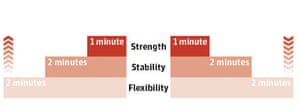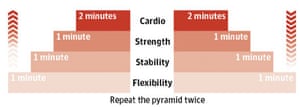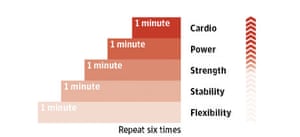Welcome to your new fitness plan. First, decide what level best suits you. You’ll find a brief description and guide to the three levels over the next few pages. For sustainable results you need to build up your fitness gradually, so if you’re not sure where to start, it’s best to begin with the Take 10 beginner’s programme.
The key to an effective exercise programme is adaption and change. If we do the same exercises day in, day out, the body is no longer challenged. So we need to perform different versions of each type of exercise every day for them to remain effective. That is at the core of this programme. Here are the five golden rules:
1 For each core fitness element we have mentioned – flexibility, stability, strength, cardio and power – there are 10 numbered exercises. Whichever programme and type of exercise you begin with, always choose exercise 1 on day 1, exercise 2 on day 2, and so on.
2 Do each exercise for the recommended time, or until you can do no more – even if it means stopping short at first. If you do stop short, continue as soon as you can to complete the full duration.
3 The speed, rhythm and intensity of the exercises are crucial, so always follow these guidelines: Static: Hold the position Slow: About three seconds per rep Fast: As fast as you can Slow/fast: Slow in the first phase, fast in the second.
4 When an exercise involves two sides of the body, split the time – half for each side.
5 For best results, make sure that on your days off you are doing at least 30 minutes of moderate activity, such as walking, and that you are following a balanced, low-fat diet.
If you’re unsure about how to do any of the exercises, you can view them in full at getsomeheadspace.com/guardian.
Take 10: beginner
If you’re completely new to exercise, or have been out of action for a while, then this is the starting place for you. It assumes that you have a sedentary job, that you do little or no exercise, but that you’re mobile and able to walk for 20 minutes.
Each 10-minute session represents a “pyramid” training pattern, where you build your intensity for the first five minutes, and then reduce your intensity for the final five minutes. In Take 10, you will only focus on the first three elements of fitness – flexibility, stability and strength – adding cardio and power at a later stage. It is essential that you climb the pyramid in the order suggested (see diagram below), paying attention to the time allocated for each exercise, and then reverse that order when you descend.
This will ensure you have a safe and effective workout.
Programme duration 10 days/2 weeks
Exercise period 10 minutes
Exercise days per week 5
Days off per week 2

On day 1, perform exercise 1 from each of the three elements, spending two minutes on flexibility, two minutes on stability and one minute on strength. On day 2, perform exercise 2 from each of the three elements, and so on. Continue in this way until you have completed all 10 exercises.
Take 20: intermediate
If you consider yourself reasonably fit and healthy but have yet to take up a regular exercise programme, or perhaps have had a rather on-off relationship with your current programme, then this is the place to start. It assumes that you have a sedentary job, that you exercise at a higher intensity at least once a week (playing a sport such as football or netball), and that you walk or are active for between 30 and 60 minutes a day.
In Take 20, you repeat the pyramid twice, building the intensity for the first five minutes, reducing it for the second five minutes, raising it again for the third five minutes, and reducing it again for the final five minutes. You’ll notice that cardio is now part of your exercise programme. Climb the pyramid in the order suggested, paying attention to the time allocated for each exercise (see diagram below), and then reverse that order when you descend.
You’ll also notice that the number of days has decreased from five in Take 10 to just four in Take 20. This is because the intensity and volume of the exercise has increased, so the body will now take longer to recover. We suggest you train on Monday, Tuesday, Thursday and Friday, giving the body plenty of time to rest between workouts.
Programme duration 20 days/5 weeks
Exercise period 20 minutes
Exercise days per week 4
Days off per week 3

On day 1, perform exercise 1 from each of the four elements. On day 2, perform exercise 2, and so on. On day 11, return to exercise 1 and continue to rotate the exercises until you have completed 20 days.
Take 30: advanced
If you consider yourself fit and active but are looking for a new challenge, then this is for you. It assumes that you either have an active job and take part in high-intensity resistance training several times a week or, if you have a sedentary job, you participate in high-intensity activity three or more times a week, and are active on the weekends in some way.
Take 30 is slightly different from Take 10 and Take 20 in that it represents a wave pattern. In this programme you will steadily raise the intensity over five minutes, before finishing and then repeating the process six times in total. You’ll also notice the fifth and final fitness element has been added – power is now part of your programme.
Climb the pyramid in the order suggested, paying attention to the time allocated for each exercise (see diagram below).
You’ll also notice that the number of days has again decreased, this time to just three days to allow the body to recover – try training on Monday, Wednesday and Friday.
Programme duration 30 days/10 weeks
Exercise period 30 minutes
Exercise days per week 3
Days off per week 4

On day 1, perform exercise 1 from each of the five elements. On day 2, perform exercise 2, and so on, until you have completed all 10 exercises. On day 11, return to exercise 1 and continue to rotate until you finish the 30-day programme.
• Andy Puddicombe is a co-founder of Headspace
Source: Read Full Article
